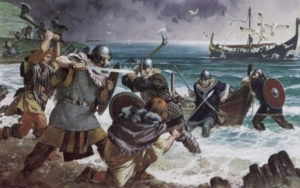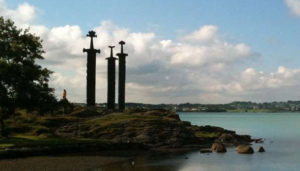Harald “Fairhair” Halfdansson, King of Norway
 According to the Royal House of Norway, Norwegian monarchy dates back more than one thousand years. Harald Fairhair, regarded as the first Norwegian king, united the petty kingships of Norway into a single realm in about 885. He reigned from c. 872 to 930. From the time of Harald Fairhair until the present day, Norway has had more than 60 named sovereigns. The current King belongs to the House of Glücksburg, which has ruled Norway since 1905. Much of Harald’s life remains uncertain, since the extant accounts of his life in the sagas were set down in writing around three centuries after his lifetime.
According to the Royal House of Norway, Norwegian monarchy dates back more than one thousand years. Harald Fairhair, regarded as the first Norwegian king, united the petty kingships of Norway into a single realm in about 885. He reigned from c. 872 to 930. From the time of Harald Fairhair until the present day, Norway has had more than 60 named sovereigns. The current King belongs to the House of Glücksburg, which has ruled Norway since 1905. Much of Harald’s life remains uncertain, since the extant accounts of his life in the sagas were set down in writing around three centuries after his lifetime.
Harald Halfdansson (Old Norse: Haraldr Hálfdanarson), better known as Harald Hårfagre English: Harald Fairhair) was born 850 in Hedemark, Norway and died 933 in Hauko, Rogaland, Norway. His father was Halfdan ‘the Black” Gudrodsson King of Vestfold born 810 in Vestfold, Norway. He died 863 in Roykensvik, Randsfjord, Oppland, Norway . His mother was Ragnhild Haraldsdotter Gulskey born 830 in Ringerike, Buskerud, Norway and died 855 Vestfold, Norway.
Harald’s father Halfdan drowned when he fell through the ice at the inlet Røykenvik in the lake Randsfjorden on his return home from Hadeland. His horse and sleigh broke through ice weakened by cattle dung near a watering hole dug in the frozen lake. He was buried in a mound at Stein in Ringerike.
Heimskringlas narrative adds that each of the districts of his kingdom wanted to claim his grave, and that it was agreed to divide his body into four pieces so each district could bury a piece of it, resulting in four different sites called Halvdanshaugen (from the Old Norse word haugr meaning mound). According to this version, only his head is buried in Ringerike.
Harald succeeded his father at the age of 10 and become King of Vestfold. His first conquest came with the suppression of a revolt in the Uplands region. A pact with Haakon, earl of Lade, enabled him to pursue conquest of the western districts. , culminating in the battle of Hafrsfjord.
 The Battle of Hafrsfjord was a great naval battle fought in Hafrsfjord sometime between 872 and 900 that resulted in the unification of Norway, later known as the Kingdom of Norway. After the battle, the victorious Viking chief Harald Fairhair proclaimed himself the first king of the Norwegians, merging several petty kingdoms under a single monarch for the first time
The Battle of Hafrsfjord was a great naval battle fought in Hafrsfjord sometime between 872 and 900 that resulted in the unification of Norway, later known as the Kingdom of Norway. After the battle, the victorious Viking chief Harald Fairhair proclaimed himself the first king of the Norwegians, merging several petty kingdoms under a single monarch for the first time
The Battle of Hafrsfjord, presumed to have taken place in about 885, is regarded as a critical battle in the process of unifying Norway. However, although the country became united under a single king in principle, it would be years before a permanent, stable governing structure was in place.
The Leidang was to be one element in this structure. The Leidang was a shared, planned defensive coastal fleet comprised of local vessels. It was initiated by Harald Fairhair’s son, Haakon I, known as Haakon The Good. The population along the coast was obliged to provide ships, manpower and provisions. Over time the duty to contribute resources to the Leidang evolved into an ordinary tax paid to the king.
the consolidation of the rule of Norway by Harald Fairhair was somewhat of a love story. The tale begins with a marriage proposal that resulted in rejection and scorn from Gyda, the daughter of Eirik, king of Hordaland. She said she refused to marry Harald “before he was king over all of Norway”. Harald was therefore induced to take a vow not to cut nor comb his hair until he was sole king of Norway, and that ten years later, he was justified in trimming it.
Harald’s conquests and taxation system led many chiefs and their followers to emigrate to the British Isles, adjacent lands, and perhaps to Iceland, which first became known to Scandinavians during the era of Harald’s rule. He acquired wealth through his control of coastal trade but ruled indirectly through lesser chieftains in areas other than his own tightly controlled home district, in the southwest. His major governmental contribution lay in the development of provincial administrations through such chieftains.
His realm was, however, threatened by dangers from outside, as large numbers of his opponents had taken refuge, not only in Iceland, then recently discovered; but also in the Orkney Islands, Shetland Islands, Hebrides Islands and Faroe Islands. His opponents’ leaving was not entirely voluntary. Many Norwegian chieftains who were wealthy and respected posed a threat to Harald; therefore, they were subjected to much harassment, prompting them to vacate the land. In time, Harald was forced to make an expedition to subdue these islands
The latter part of Harold’s reign was troubled by strife among his sons, who numbered between 16 and 20. One, Haakon the Good, was fostered in England under Athelstan. To all Harold assigned titles, lands, and rights of governing in designated areas. Toward the end of his life, he bestowed supreme authority upon a child of his old age, Erik “Bloody Axe.”
References:
- Krag, Claus. “Harald 1 Hårfagre”. Norsk biografisk leksikon. http://snl.no/.nbl_biografi/Harald_1_H%C3%A5rfagre/utdypning. Retrieved 3 September 2012.
- According to Peter H. Sawyer, this expedition probably never took place, cf. “Harald Fairhair and the British Isles”, in “Les Vikings et leurs civilisation”, ed. R. Boyer (Paris, 1976), pp. 105-9
- Heimskringla, by Snorri Sturluson
Related Reading:
- Viking Empires by Angelo Forte, Richard Oram and Frederik Pedersen (Cambridge University Press. June 2005)
- The Oxford Illustrated History of the Vikings Peter Sawyer, Editor (Oxford University Press, September 2001)
- Raffensperger, Christian, “Shared (Hi)Stories: Vladimir of Rus’ and Harald Fairhair of Norway,” The Russian Review, 68,4 (2009), 569-582
________________________________________________________________________
Relationship Report
for
John Edward BLACK
and
Harald I “Fair Hair” HALFDANSSON 1st King of Norway b.850
———————————————————————————————————————————-
Harald I “Fair Hair” HALFDANSSON 1st King of Norway is the 41st great-grandfather of John Edward BLACK.
Lines of relations from
Harald I “Fair Hair” HALFDANSSON 1st King of Norway
——————————————————— / ———— \ —————————————————–
Harald I “Fair Hair” HALFDANSSON 1st King of Norway b.850
Sigurd Rise HARALDSSON b.895
HALVDAN SIGURDSDATTER b.920
Moramer of Atholl Duncan O’NEILL b.960
Crinan Thane DEMORMAER Lay Abbot of Dunkeld b.980
Crinan Of Dunkeld CANMORE I. b.976
Maldred MAC CRÍNÁN Earl of Dunbar b.1015
Gospatric I Earl of Northumbria DUNBAR b.1040
Athelreda Lady of Athol and the Isles DUNBAR b.951
Crinan of Dunkeld Abbot of the Monastery of DUNKELD b.980
Maldred MAC CRÍNÁN Earl of Dunbar b.1015
Gospatric EARL OF DUNBAR b.1040
Gospatric II b.1062
Margaret DE DUNBAR b.1100
Sir Robert DE MONTGOMERY, 1st Laird of Eaglesham b.1129
Sir Alan DE MONTGOMERY II Laird Eaglesham b.1144
John de MONTGOMERY b.1170
Laird Alan de MONTGOMERY IV of Eaglesham b.1188
Sir John MONTGOMERIE b.1208
Margaret DE MONTGOMERY b.1235
Archibald MURE b.0
William, Lord Rowallan MURE b.1265
Sir Adam MURE b.1293
Countess Elizabeth MURE of Rowallan b.1315
Elizabeth STEWART b.1346
Thomas DE LA HAYE b.1380
Alice DE LA HAYE b.1425
Sir. Robert TATE THWAITES b.1440
Mary Agnes TATE b.1472
Thomas CHANDLER II b.1500
Thomas Tobias CHANDLER III b.1525
John CHANDLER b.1573
Edmund CHANDLER OR CHAUNDELER b.1588
Sarah CHANDLER b.1616
Rebecca SIMMONS b.1635
John SOULE Jr. b.1675
Sarah SOULE b.1703
Samuel SNOW b.1729
Samuel SNOW Jr b.1752
Ebenezer SNOW b.1784
Bernard SNOW b.1822
Minnie SNOW b.1869
Mary Beatrice DASTRUP b.1902
John Edward BLACK
